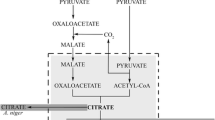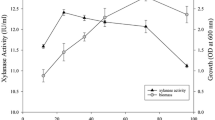Abstract
In this study, the medium requirements to increase the production of xylitol by using Candida tropicalis (CT) have been investigated. The technique of single addition or omission of medium components was applied to determine the nutritional requirements. The addition of amino acids such as Asp, Glu, Gln, Asn, Thr, and Gly had no significant effect on CT growth. However, in the absence of other metal ions, there was a higher concentration of cell growth and xylitol production when only Zn2+ was present in the medium. The analysis of various vitamins unveiled that biotin and thiamine were the only vitamins required for the growth of CT. Surprisingly, when only biotin was present in the medium as a vitamin, there was less growth of CT than when the medium was complete, but the amount of xylitol released was significantly higher. Overall, this study will increase the xylitol production using the single omission or addtion technique.

Similar content being viewed by others
References
Makinen KK (1979) Xylitol and oral health. Adv Food Res 25:137–157. https://doi.org/10.1016/S0065-2628(08)60236-0
Ylikahri R (1979) Metabolic and nutritional aspects of xylitol. Adv Food Res 25:159–180. https://doi.org/10.1016/S0065-2628(08)60237-2
Radhakrishnan R, Lee I-J (2017) Foliar treatment of Bacillus methylotrophicus KE2 reprograms endogenous functional chemicals in sesame to improve plant health. Indian J Microbiol 57:409–415. https://doi.org/10.1007/s12088-017-0666-0
Soares LCS, Chandel AK et al (2016) Screening of yeasts for selection of potential strains and their utilization for in situ microbial detoxification (ISMD) of sugarcane bagasse hemicellulosic hydrolysate. Indian J Microbiol 56:172–181. https://doi.org/10.1007/s12088-016-0573-9
Pepper T, Olinger PM (1988) Xylitol in sugar-free confections. Food Technol 42:98–106
Gao H, Kim TS, Mardina P, Zhou P, Wen F, Lee J-K (2016) Rare sugar production by coupling of NADH oxidase and l-arabinitol dehydrogenase. RSC Adv 6:66609–66616. https://doi.org/10.1039/C6RA11614K
Dhiman SS, Haw JR, Kalyani D, Kalia VC, Kang YC, Lee J-K (2015) Simultaneous pretreatment and saccharification: green technology for enhanced sugar yields from biomass using a fungal consortium. Bioresour Technol 179:50–57. https://doi.org/10.1016/j.biortech.2014.11.059
Prabhu P, Doan TN, Tiwari M, Singh R, Kim SC, Hong MK, Kang YC, Kang LW, Lee J-K (2014) Structure-based studies on the metal binding of two-metal-dependent sugar isomerases. FEBS J 15:3446–3459. https://doi.org/10.1111/febs.12872
Jagtap SS, Dhiman SS, Kim TS, Li J, Lee J-K (2013) Enzymatic hydrolysis of aspen biomass into fermentable sugars by using lignocellulases from Armillaria gemina. Bioresour Technol 133:307–314. https://doi.org/10.1016/j.biortech.2013.01.118
Jagtap SS, Dhiman SS, Jeya M, Kim I-W, Lee J-K (2013) Characterization of a β-1,4-glucosidase from a newly isolated strain of Pholiota adiposa and its application to the hydrolysis of biomass. Biomass Bioenergy 54:181–190. https://doi.org/10.1016/j.biombioe.2013.03.032
Hui G, Tiwari M, Jeya M, Lee J-K (2012) Characterization of H2O-forming NADH oxidase from Streptococcus pyogenes and its application in L-rare sugar production. Bioorg Med Chem Lett 22:1931–1935. https://doi.org/10.1016/j.bmcl.2012.01.049
Jeya M, Nguyen N-P-T, Moon H-J, Kim S-H, Lee J-K (2010) Conversion of woody biomass into fermentable sugars by cellulase from Agaricus arvensis. Bioresour Technol 101:8742–8749. https://doi.org/10.1016/j.biortech.2010.06.055
Kim JH, Lim B-C, Yeom S-J, Kim Y-S, Kim HJ, Lee J-K, Lee SH, Kim SW, Oh DK (2008) Differential selectivity of the Escherichia coli cell membrane shifts the equilibrium for the enzyme-catalyzed isomerization of galactose to tagatose. Appl Environ Microbiol 74:2307–2313. https://doi.org/10.1128/AEM.02691-07
Pagolu R, Singh R, Shanmugam R, Kondaveeti S, Patel SKS, Kalia VC, Lee J-K (2021) Site-directed lysine modification of xylanase for oriented immobilization onto silicon dioxide nanoparticles. Bioresour Technol 331:125063. https://doi.org/10.1016/j.biortech.2021.125063
Fernandes AMO, Garcia NFL, Fonseca GG, Leite RSR, Da Paz MF (2020) Evaluation of the fermentative capacity of Saccharomyces cerevisiae CAT-1 and BB9 strains and Pichia kudriavzevii BB2 at simulated industrial conditions. Indian J Microbiol 60:494–504. https://doi.org/10.1007/s12088-020-00891-6
Veerasamy M, Venkataraman K et al (2018) Point of care tuberculosis sero-diagnosis kit for wild animals: combination of proteins for improving the diagnostic sensitivity and specificity. Indian J Microbiol 58:81–92. https://doi.org/10.1007/s12088-017-0688-7
Xue D, Yao D, You X, Gong C (2020) Green synthesis of the flavor esters with a marine Candida parapsilosis esterase expressed in Saccharomyces cerevisiae. Indian J Microbiol 60:175–181. https://doi.org/10.1007/s12088-020-00856-9
Kalia VC, Patel SKS, Cho B-K, Wood TK, Lee J-K (2021) Emerging applications of bacteria as anti-tumor agents. Sem Cancer Biol. https://doi.org/10.1016/j.semcancer.2021.05.012
Miller TL, Churchill BW (1986) Substrates for large-scale fermentations. In: Demain AL, Solomon NA (eds) Manual for industrial microbiology and biotechnology. American Society for Microbiology, Washington, DC, pp 122–136
Kumar V, Patel SKS, Gupta RK, Otari SV, Hui G, Lee J-K, Zhang L (2019) Enhanced saccharification and fermentation of agricultural waste using an immobilized enzyme cocktail. Biotechnol J 14:1800468. https://doi.org/10.1002/biot.201800468
Tiwari M, Moon H-J, Jeya M, Lee J-K (2010) Cloning and characterization of a thermostable xylitol dehydrogenase from Rhizobium etli CFN42. Appl Microbiol Biotechnol 87:571–581. https://doi.org/10.1007/s00253-010-2478-6
Zhang Y-W, Tiwari M, Jeya M, Lee J-K (2011) Covalent immobilization of recombinant Rhizobium etli CFN42 xylitol dehydrogenase onto modified silica nanoparticles. Appl Microbiol Biotechnol 90:499–507. https://doi.org/10.1007/s00253-011-3094-9
Kalia VC, Gong C, Patel SKS, Lee J-K (2021) Regulation of plant mineral nutrition by signal molecules. Microorganisms 9:774. https://doi.org/10.3390/microorganisms9040774
Patel SKS, Gupta RK, Kalia VC, Lee J-K (2021) Integrating anaerobic digestion of potato peels to methanol production by methanotrophs immobilized on banana leaves. Bioresour Technol 323:124550. https://doi.org/10.1016/j.biortech.2020.124550
Hong JH, Kim JH, Park GD, Lee JY, Lee J-K, Kang YC (2021) A strategy for fabricating three-dimensional porous architecture comprising metal oxides/CNT as highly active and durable bifunctional oxygen electrocatalysts and their application. Chem Eng J 414:128815. https://doi.org/10.1016/j.cej.2021.128815
Kalia VC, Patel SKS, Shanmugam R, Lee J-K (2021) Polyhydroxy alkanoates: trends and advances towards biotechnological applications. Bioresour Technol 326:124737. https://doi.org/10.1016/j.biortech.2021.124737
Kalyani D, Tiwari M, Li J, Kim SC, Kalia VC, Kang YC, Lee J-K (2015) A highly efficient recombinant laccase from the yeast Yarrowia lipolytica and its application in the hydrolysis of biomass. PLoS ONE 10:e0120156. https://doi.org/10.1371/journal.pone.0120156
Kumar P, Ray S, Patel SKS, Lee J-K, Kalia VC (2015) Bioconversion of crude glycerol to polyhydroxyalkanoate by Bacillus thuringiensis EGU45 under high nitrogen concentration. Int J Biol Macromol 78:9–16. https://doi.org/10.1016/j.ijbiomac.2015.03.046
Demirbas A (2021) Comparison study of synthesized red (or blood) orange peels and juice extract-nanoflowers and their antimicrobial properties on fish pathogen (Yersinia ruckeri). Indian J Microbiol. https://doi.org/10.1007/s12088-021-00945-3
Matthews CB, Kuo A, Love KR, Love JC (2018) Development of a general defined medium for Pichia pastoris. Biotechnol Bioeng 115:103–113. https://doi.org/10.1002/bit.26440
Patel SKS, Ray S, Prakash J, Wee JH, Kim S-Y, Lee J-K, Kalia VC (2019) Co-digestion of biowastes to enhance biological hydrogen process by defined mixed bacterial cultures. Indian J Microbiol. 59:154–160. https://doi.org/10.1007/s12088-018-00777-8
Patel SKS, Kim JH, Kalia VC, Lee J-K (2019) Antimicrobial activity of amino-derivatized cationic polysaccharides. Indian J Microbiol 59:96–99. https://doi.org/10.1007/s12088-018-0764-7
Ausubel F, Brent R, Kingston RE, Moore DD, Seidman JG, Smith JA, Struhl K (1986) Short protocols in molecular biology, 3rd edn. Wiley, New York, p 836
Chiang C, Knight SG (1966) d-Xylose reductase and xylitol dehydrogenase from Penicillium chrysogenum. Methods Enzymol 9:188–193. https://doi.org/10.1016/0076-6879(66)09044-X
Singh RK, Singh R, Sivakumar D, Kondaveeti S, Kim T, Li J, Sung BH, Cho B-K, Kim DR, Kim SC, Kalia VC, Zhang Y-HPJ, Zhao H, Kang YC, Lee J-K (2018) Insights into cell-free conversion of CO2 to chemicals by a multienzyme cascade reaction. ACS Catal 8:11085–11093. https://doi.org/10.1021/acscatal.8b02646
Zhu Y-H, Liu C-Y, Cai S, Guo L-B, Kim I-W, Kalia VC, Lee J-K, Zhang Y-W (2019) Cloning, expression, and characterization of a highly active alcohol dehydrogenase for production of ethyl (S)-4-chloro-3-hydroxybutyrate. Indian J Microbiol 59:225–233. https://doi.org/10.1007/s12088-019-00795-0
Kondaveeti S, Patel SKS, Woo J, Wee JH, Kim S-Y, Al-Raoush RI, Kim I-W, Kalia VC, Lee J-K (2020) Characterization of cellobiohydrolases from Schizophyllum commune KMJ820. Ind J Microbiol 60:160–166. https://doi.org/10.1007/s12088-019-00843-9
Lee J-K, Patel SKS, Sung BH, Kalia VC (2020) Biomolecules from municipal and food industry wastes: an overview. Bioresour Technol 298:122346. https://doi.org/10.1016/j.biortech.2019.122346s
Acknowledgements
This research was supported by Basic Science Research Program through the NRF funded by the Ministry of Science, ICT & Future Planning (NRF-2019R1F1A1063131, NRF-2020R1I1A1A01073483, NRF-2019R1C1C1009766). This work was also supported by KU Research Professor program of Konkuk University. This paper was supported by Konkuk University Researcher Fund in 2019.
Author information
Authors and Affiliations
Corresponding authors
Additional information
Publisher's Note
Springer Nature remains neutral with regard to jurisdictional claims in published maps and institutional affiliations.
Rights and permissions
About this article
Cite this article
Muneeswaran, G., Patel, S.K.S., Kondaveeti, S. et al. Biotin and Zn2+ Increase Xylitol Production by Candida tropicalis. Indian J Microbiol 61, 331–337 (2021). https://doi.org/10.1007/s12088-021-00960-4
Received:
Accepted:
Published:
Issue Date:
DOI: https://doi.org/10.1007/s12088-021-00960-4




